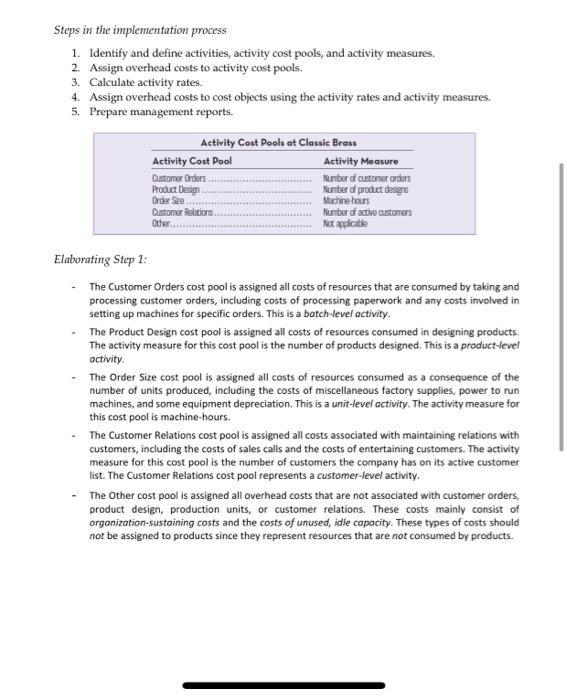Steps in the implementation process 1. Identify and define activities, activity cost pools, and activity measures. 2. Assign overhead costs to activity cost pools. 3. Calculate activity rates 4. Assign overhead costs to cost objects using the activity rates and activity measures. 5. Prepare management reports. Activity Cost Pools at Classic Brass Activity Cost Pool Activity Measure Customer Orders Number of customer orders Product Design Number of product designs Order Size Machine hours Customer Relations Nurmber of active customers Other Not applicable Elaborating Step 1: The Customer Orders cost pool is assigned all costs of resources that are consumed by taking and processing customer orders, including costs of processing paperwork and any costs involved in setting up machines for specific orders. This is a batch-level activity. The Product Design cost pool is assigned all costs of resources consumed in designing products. The activity measure for this cost pool is the number of products designed. This is a product-level activity The Order Size cost pool is assigned all costs of resources consumed as a consequence of the number of units produced, including the costs of miscellaneous factory supplies, power to run machines, and some equipment depreciation. This is a unit-level activity. The activity measure for this cost pool is machine hours. The Customer Relations cost pool is assigned all costs associated with maintaining relations with customers, including the costs of sales calls and the costs of entertaining customers. The activity measure for this cost pool is the number of customers the company has on its active customer list. The Customer Relations cost pool represents a customer-level activity. - The Other cost pool is assigned all overhead costs that are not associated with customer orders, product design, production units, or customer relations. These costs mainly consist of organization-sustaining costs and the costs of unused, idle capacity. These types of costs should not be assigned to products since they represent resources that are not consumed by products. Steps in the implementation process 1. Identify and define activities, activity cost pools, and activity measures. 2. Assign overhead costs to activity cost pools. 3. Calculate activity rates 4. Assign overhead costs to cost objects using the activity rates and activity measures. 5. Prepare management reports. Activity Cost Pools at Classic Brass Activity Cost Pool Activity Measure Customer Orders Number of customer orders Product Design Number of product designs Order Size Machine hours Customer Relations Nurmber of active customers Other Not applicable Elaborating Step 1: The Customer Orders cost pool is assigned all costs of resources that are consumed by taking and processing customer orders, including costs of processing paperwork and any costs involved in setting up machines for specific orders. This is a batch-level activity. The Product Design cost pool is assigned all costs of resources consumed in designing products. The activity measure for this cost pool is the number of products designed. This is a product-level activity The Order Size cost pool is assigned all costs of resources consumed as a consequence of the number of units produced, including the costs of miscellaneous factory supplies, power to run machines, and some equipment depreciation. This is a unit-level activity. The activity measure for this cost pool is machine hours. The Customer Relations cost pool is assigned all costs associated with maintaining relations with customers, including the costs of sales calls and the costs of entertaining customers. The activity measure for this cost pool is the number of customers the company has on its active customer list. The Customer Relations cost pool represents a customer-level activity. - The Other cost pool is assigned all overhead costs that are not associated with customer orders, product design, production units, or customer relations. These costs mainly consist of organization-sustaining costs and the costs of unused, idle capacity. These types of costs should not be assigned to products since they represent resources that are not consumed by products







